The African Violet plant is among the most popular plants to keep in your home. These plants are small but eye catching with many colors and leaf patterns available. Plant lovers often collect them and show off these bright cuties in colorful groupings.
African violets (Saintpaulia ionantha) belong to the Gesneriaceae family, which includes over 3,000 species of plants, many of which are also popular houseplants. This family of plants is known for its showy flowers, often with bright colors and interesting shapes, as well as their ease of care and diverse growth habits. Other members of the Gesneriaceae family include gloxinias, lipstick plants, and flame violets.
These beautiful little plants are a stunning addition to any plant collection. They will flower almost year round. These plants originate from tropical Eastern Africa. They enjoy bright light and some humidity to keep them happy.
In general African Violets are not hard to take care of. The African Violet plant does great when grown in proper lighting with a good watering schedule. There are a few pitfalls that a new plant owner can fall into. We will discuss that in the post and learn how to properly care for these gorgeous plants.
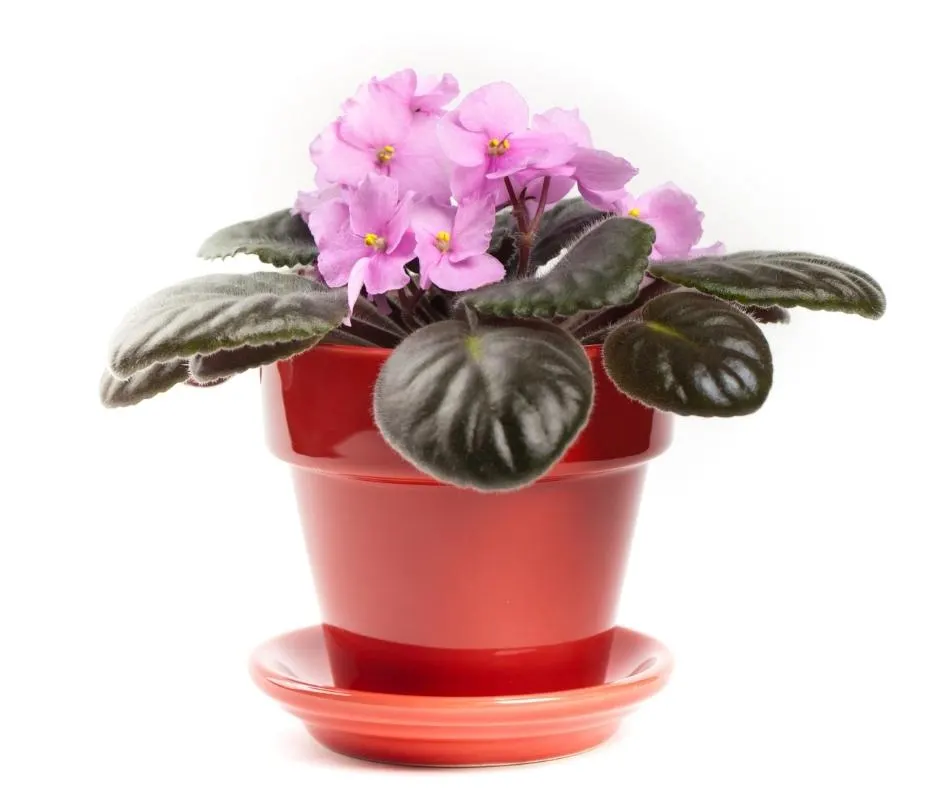
Fun Facts About the African Violet Plant:
- Native to Tanzania: African violets are native to Tanzania in East Africa, where they grow in shady areas on rocky terrain.
- First introduced in Europe in the 19th century: African violets were first introduced to Europe in the 19th century and quickly became popular houseplants due to their beautiful flowers and ease of care.
- Wide range of colors: African violets come in a wide range of colors, including pink, purple, blue, red, and white.
- Different flower types: African violets can have different types of flowers, such as single, double, or semi-double blooms.
- Variegated leaves: Some African violets have variegated leaves, meaning they have a mix of colors or patterns on their leaves.
- Easy to care for: African violets are relatively easy to care for and can thrive in low to medium light conditions. They prefer to be kept moist but not waterlogged and should be fertilized regularly.
- Propagation: African violets can be propagated from leaf cuttings, making them a popular plant for sharing with friends and family.
- Health benefits: African violets have been shown to have health benefits, such as improving air quality by removing toxins from the air.
Varieties of African violets:
There are many different varieties of African violets (Saintpaulia ionantha) sold as houseplants. New cultivars are developed every year and different sources may classify varieties differently. But there are probably thousands of African violet cultivars available, with new lovely creative varieties being developed and introduced all the time.
African violets come in a wide range of colors, including pink, purple, blue, red, and white, and can have different types of flowers, such as single or double blooms. They can also have different leaf shapes, sizes, and textures, and some have variegated leaves.
The look of the African violet plant is not just all bout the blossom colors. Leaf and blossoms come in different looks, variegations and colors. But the size and growth habits of African violets are also quite diverse. You may find…
Miniature African Violet: This name is used for smaller varieties of African violets that are popular for their compact size and delicate flowers.
Standard African Violet: This name is used for larger varieties of African violets that can grow up to 12 inches in diameter.
Trailer African Violet: This name is used for African violets that have a trailing habit, making them ideal for hanging baskets.
Buy African Violets from Etsy
If you’re not picky about the quality, growth habit or color of your African violet plant, You can source them from most local nurseries or greenhouses.
However, If you are looking for a specific variety of leaf, or special color or blossom style, check out Etsy for a whole range of varieties. Buying online is a great way to get ahold of plants that aren’t sold locally.
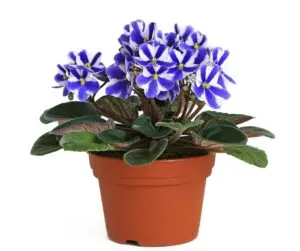
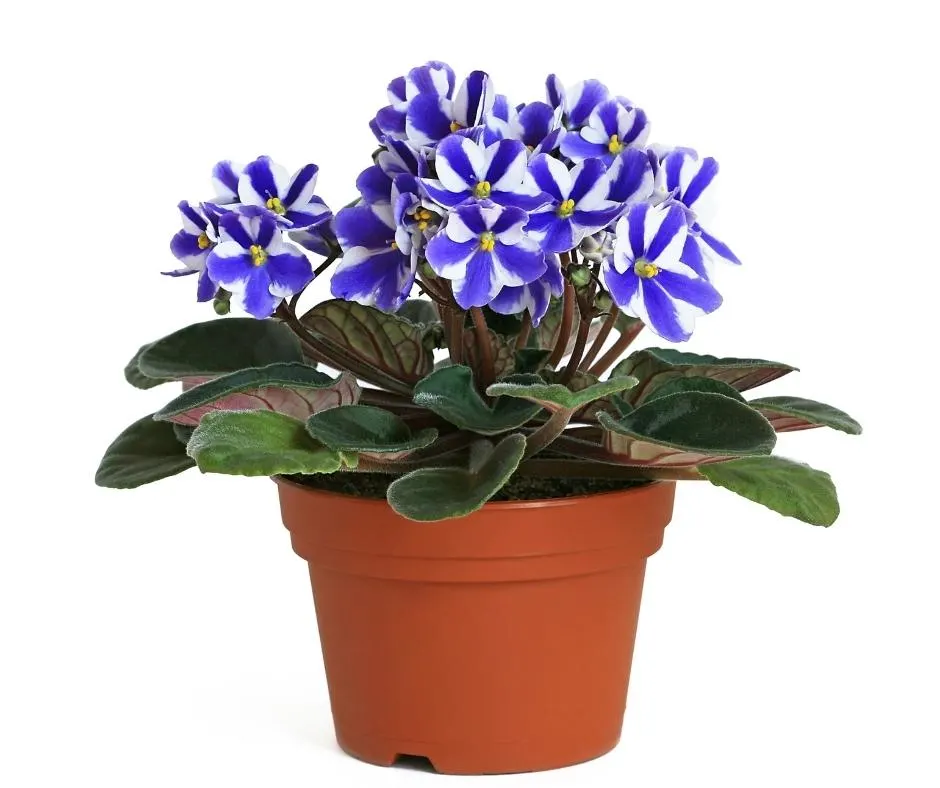
Common Care Problems with African Violets:
Are African violet plants hard to care for? Not really. But they do have some specific care needs to help them grow to their fullest potential and show off those delightful leaves and blooms.
Here are some of the Plant Care Issues of African violet plants:
- Pests: Cyclamen Mites, Thrips, Mealybugs, and Spider Mites are all knows pests that can infect African violets.
- Diseases: Powdery Mildew, Bacterial Blight, Crown Rot, Root Rot, and Ring Spot are all common diseases for this plant.
- Leggy Growth: This most often is the result of poor lighting conditions. If you are growing your plant in lower light, it will stretch and reach the leaves towards the light source.
- Leaf Spots: When the leaves are splashed with cold water, they can develop spots called “Ring Spots”. Best to use bottom watering with African violets to avoid spotted leaves.
- Not Flowering: African Violets can stop producing blooms if in poor lighting conditions, crowded top growth, the wrong soil, and low humidity.
- Pale and Bleached Leaves: This often occurs when the plant is left in bright sunlight. Too much light can bleach out the leaves.
- Leaf Curling: African Violets do not like to be cold. When they get exposed to temperatures that are too chilly, they will often have curling leaves.
- Browning Leaves: This usually occurs when your plant has too much fertilizer around the roots.
- Limp or Drooping Leaves: Watering issues can cause the leaves to droop. This happens when the plant is either too dry, or overwatered.
Is it ok to touch African violet leaves? Most African violet plant leaves are fuzzy and tempting to touch. And the blossoms are so pretty. To keep those leaves and blossoms beautiful, it’s best not to touch them. They are fragile and will not stand up well to handling.
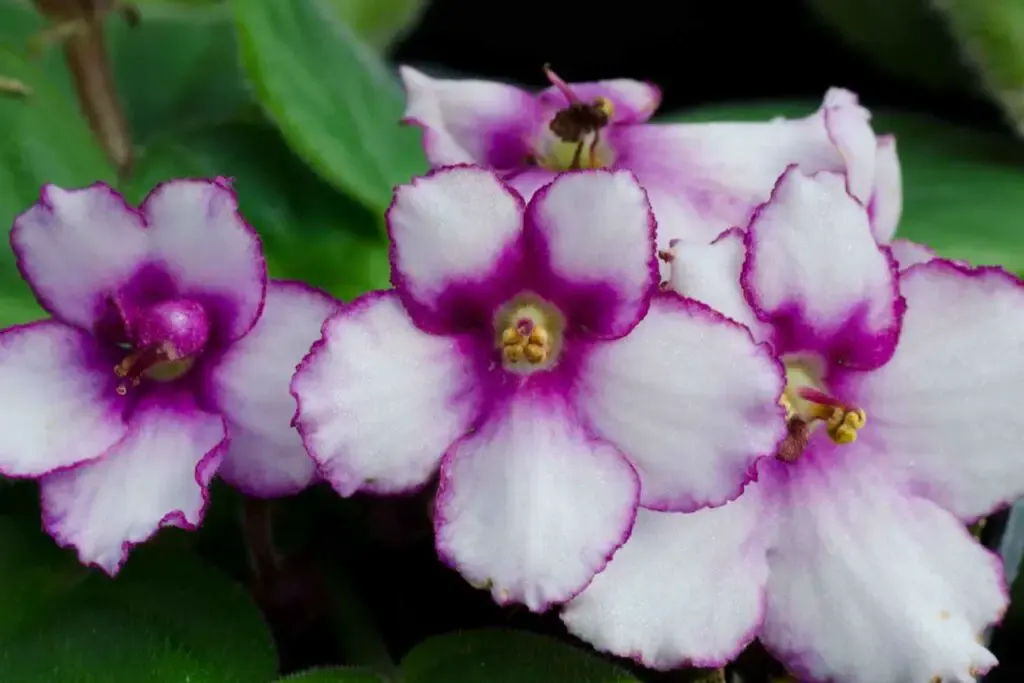
How to Properly Water African Violet Plants
How often do you water African violet? When the soil is almost dry. Depending on conditions, this could be weekly. However, Proper watering is very important for African Violets and needs to follow the plant needs rather than the calendar.
These plants require a tricky balance of moist soil but not over saturated soil. One of the most common pitfalls people make is overwatering this plant which quickly results in root rot. Only water an African violet plant when the top of the soil is dry, usually every one to two weeks.
Bottom watering is the best method for watering African Violets. These plants have beautiful fuzzy leaves are easily damaged from water drops on the leaves. If you decide to water your plant from the top, use a funnel or narrow watering can to avoid getting water on the leaves.
A self watering pot with a wicking system is a popular way to water African Violet plants that uses the bottom watering concept is a all in one pot. No trays or mess. These pots allow the plant to wick the moisture up into the roots without over saturating it.
Do African violets need to be misted? Please do not EVER mist the leaves of African violets. They will get (sometimes permanent) leaf spots, and are very susceptible to crown rot. That is when the center of the plant rots from too much water applied topically. Stay away from the misting can with these plants.
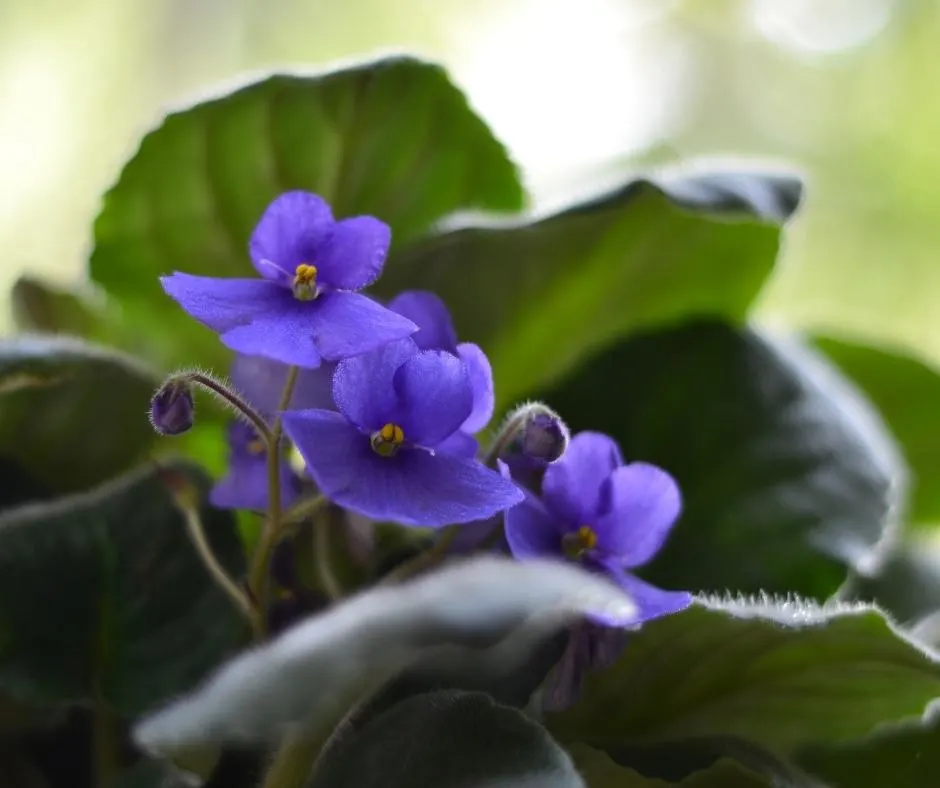
Fertilizing African Violet Plants
Fertilizing African Violet plants is extremely important. Proper fertilizer can help support the plant while it blooms beautiful flowers. The recommended feeding schedule is every 4-6 weeks.
African Violets need a fertilizer ratio of 14-12-14. A mix of Nitrogren, Phosphorus, and Potassium. A water soluble fertilizer is the best option for African Violets.
Epsom salts can help encourage blooming in African Violets. Simply add 2 tablespoons of pure epsom salts into a gallon of distilled water. Stir really well and use the mixture to water your plants.

Pruning and Maintaining your African Violet
After your African Violet finishes blooming, it is important to dead head or prune back the old blooms. This will keep your plant healthy and encourage it to continue putting out new blooms.
As your plant grows it will start to produce “suckers” or “pups” These are tiny baby plants that start to grow off of the mother plant. These suckers can be detrimental to your plant if left to grow uninhibited. Not only do they take nutrients from the mother plant, they also grow large and start crowding the leaves together.
How do we propagate an African violet plant? You can remove the suckers and propagate them into a new plant. This is done by carefully dividing them away from the mother plant. Cut them off with sharp sterile pruning shears and place them in a 50/50 mix of vermiculite and sand. Put the small new pot of suckers in a gallon bag filled with air. Keep the soil moist while the new suckers grow roots and become new healthy plants.
We have put together a simple and printable care guide with all of the care needs for this plant.
| Familiar Names | African violets |
| Scientific Name | Saintpaulia ionantha |
| Plant Family | Gesneriaceae |
| Care Difficulty | Not difficult. When properly maintained, African violets grow well with little fuss. |
| Temperature | A range between 60-80°F (15-27°C) is ideal. Temperatures below 60°F (15°C)or above 85 (29 C) can cause damage to the plant and should be avoided. |
| Watering | Water when soil is slightly moist in the root zone. Bottom watering preferred. |
| Humidity | African violets prefer moderate humidity levels, ideally around 40-60%. Use a pebble tray or plant grouping to increase humidity if needed. |
| Soil | The ideal soil for African violets should be light, porous, and slightly acidic, with a pH between 6.0 and 6.5. The soil should also be rich in organic matter to provide the plant with essential nutrients |
| Fertilizer | Use a fertilizer specifically formulated for African violets, as they have specific nutrient requirements.dilute the fertilizer according to the manufacturer’s instructions and apply it to the soil every 2-4 weeks during the growing season |
| Lighting | African violets need bright indirect light. Too much direct sunlight can burn the leaves and cause damage to the plant, while too little light can result in a lack of flowering and stunted growth |
| Growth Habit | Compact, bushy growth habit with rosettes of leaves that grow close to the ground. African violets grow relatively slowly. They usually reach maximum height of 6-8 inches (15-20 cm) in a year, with a spread of 6-12 inches (15-30 cm). |
| Pruning: | To Maintain a well shaped lovely plant: Remove old, dead or yellowing leaves, Pinch off spent blooms, Trim back leggy stems. For best plant health, avoid pruning during dormancy. |
| Propagation: | African violets can be propagated easily with various methods. Leaf Propagation, division, crown division and runner propagation all work well to propagate African violets. Choose the one that best suits the variety you have. |
African Violet Care Guide
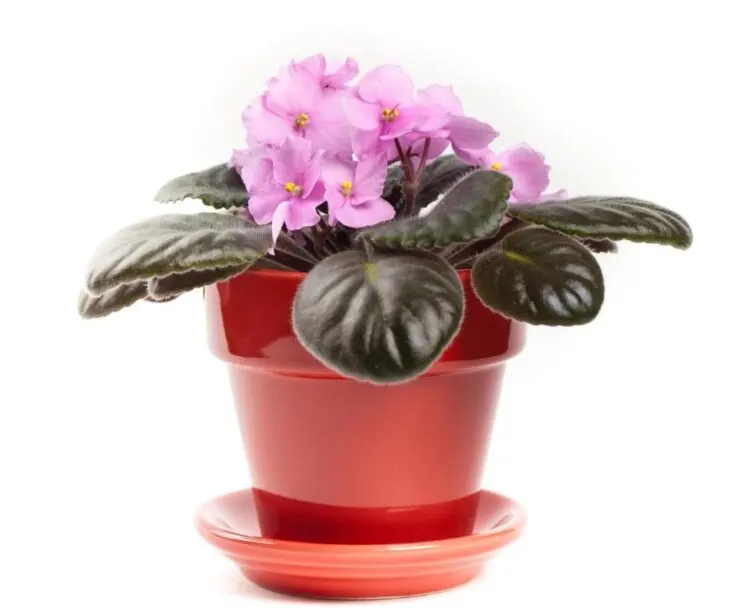
African Violets are beautiful plants to add to your home! WIth a little bit of love and care, your can have happy and healthy African Violet plants.
Tools
- Plant Pot (ceramic, plastic, or terra cotta)
- Potting medium
Instructions
Soil Preference:
- African Violets prefer well draining substrates. The roots will rot quickly if they sit in moist soil.
- Use a potting mix specific to African Violets
- Make a mix of 2 parts peat moss, 1 part perlite and 1 part vermiculite or sand. This mix will keep the roots areated.
- Make sure your pot has drainage at the bottom.
Pot Size and Type:
- African Violets can grow in many different kinds of pots. Self Watering pots with a wick system are a great option for these plants.
- Repot every year or when roots come out the drainage holes on the pot bottom To the next pot size up. Don't jump to a huge pot from a small one. Just go to the next size up pot.
- NOTE: African Violets like to be slightly root bound. They bloom best when they are in a smaller tight pot.
Lighting:
- This plant loves the light. It will tolerate bright indirect light.
- Do not leave this plant in direct sunlight for hours a day. The leaves may burn and become pale or bleached
- South or East facing windows are best for this plant.
- Low light can cause poor plant growth and leggy stems.
- You can supplement low lighting with artificial grow lights.
Watering:
- Water the African Violet when the top soil is dry. About every 1-2 weeks
- Bottom watering is the best option for this plant.
- Do not allow water to hit the leaves. This can cause damage and spots to the leaves..
- A self watering pot can be helpful to maintain the proper water ratio.
- Watering is best done on a regular schedule so the plant is not over or under watered. Both can cause stress on the plant.
- Never let this plant get wet feet. Overwatering can cause root rot and attract fungus gnats to your plant.
- Underwatering causes the leaves to turn brown.
How to Fertilize:
1. Use a good quality fertilizer meant for African Violets
2. This plant is a heavy feeder due to it blooming frequently.
3. Fertilize every 4-6 weeks through the blooming season.
Temperature:
- The African Violet plants like to be kept warm.
- This plant will do best between 65 and 80 F.
- Indoors room temperature is fine for these plants. Just keep the plant away from cold drafty windows in the winter.
Leaf Care:
- African Violet leaves can accumulate dust and debris due to the fuzzy texture.
- Clean leaves can help keep pests away from your plant and help it photosynthesize properly.
- To clean the leaves, gently brush them with a small brush. You can use a tiny paint brush with very soft bristles.
Pests:
- This plant is a hardy resilient plant. However all plants can get attacked by pests.
- Stress by longterm overwatering, poor light, extreme temperatures and soil conditions are contributors to plant stress..
- Spider mites, mealy bugs, scale, thrips and whitefly are the most common houseplant pests you will see.
- Read our post on How to get rid of aphids and other pests with our homemade pesticide soap recipe or neems oil.
- To minimize the possibility of pests be sure to check all nursery plants before bringing them home.
- Quarantine all new plants until you are sure no pests live in them.
How to Propagate:
- African Violets can be propagated by leaf cuttings.
- Cut a firm and healthy leaf off with a sharp sterile knife or scissors.
- Make sure you cut 1-1.5 inches aboove the petiole
- Plant the leaf cutting in a pot with 50/50 vermiculite and coarse sand.
- Place the plant in a gallon bag filled with air. (this creates a tiny humid greenhouse for the cuttings)
- Keep the soil mix moist while the leaf is growing new roots.
- Roots will form around 3-4 weeks.
Notes
This plant is non-toxic for cats, dogs, and horses. It is also a safe plant to have around children.
African Violet Care Supplies
Thank you for stopping by The Contented Plant! If you have any questions about this plant, or it’s care, you can leave a comment down below. We will do our best to help you out!
For further reading on African Violet care you can check out this helpful resource we found.
Follow Us:
Find us on YouTube, Instagram , Pinterest and TikTok! We love to Plant chat. We also comment, like and occasionally share your content to our daily stories. We’d love to see your plants. Share your joy in your houseplants. Happy Planting!
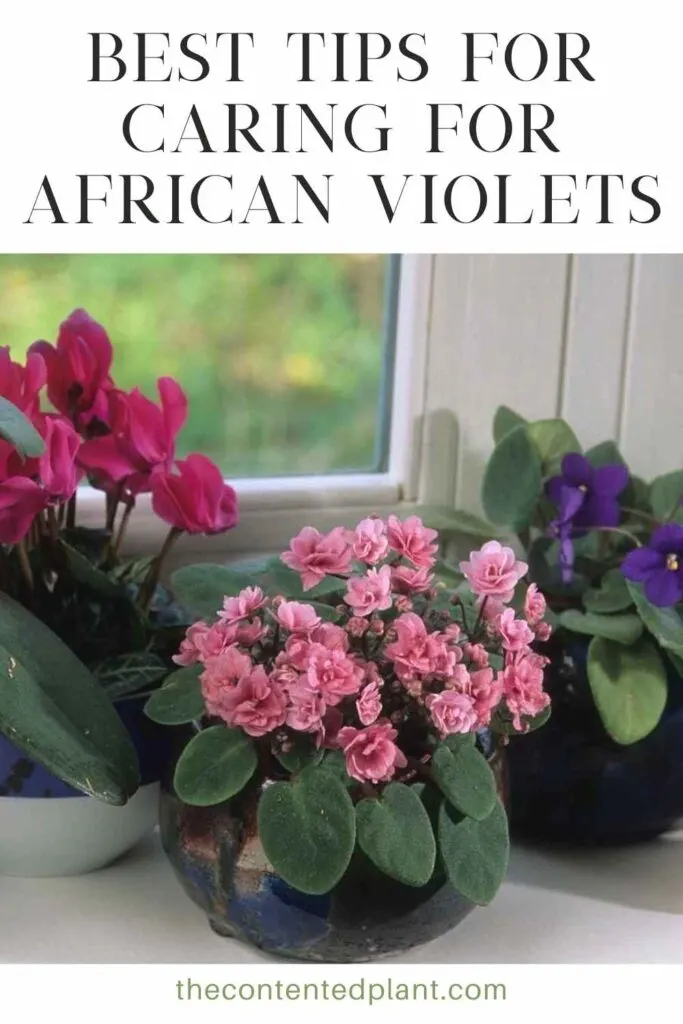







How To Repot A Plant - The Contented Plant
Thursday 13th of October 2022
[…] a cute set of pots for a plant collection like orchids or African violets, can show them off and create a wonderful visual in your […]
How to Get Rid of Powdery Mildew on Plants-Treatment Guide - The Contented Plant
Tuesday 15th of March 2022
[…] indoor plants, mildew is unsightly and can spread quickly among plants grouped together like African violets, begonias and other fuzzy leaved […]